German Bread (Authentic Vollkornbrot)
This post may contain affiliate links. See my disclosure policy.
A thoroughly authentic German Bread Recipe (Vollkornbrot)! This delicious traditional German whole grain seed bread is nutrient dense with a fabulous texture and positively packed with flavor. This makes a large loaf that freezes well so you can conveniently grab some whenever you’re in the mood.

Authentic German Bread (Vollkornbrot)
Few things are better than a freshly baked loaf of bread slathered down with butter and some good jam. That’s true for crusty breads with fluffy interiors and the more hearty, dense breads that I also know and love from Europe. Here is a German bread that is beloved throughout Germany and is also widely enjoyed in Austria and Switzerland. It features a grain called Einkorn that is used throughout much of western Europe, but feel free to substitute other grains according to your preference.
Dense, chewy, packed with nutrition and full of flavor, this whole grain German brown bread (Vollkornbrot) is wonderful with your choice of butter, jam, Nutella, cheese, or cold cuts.
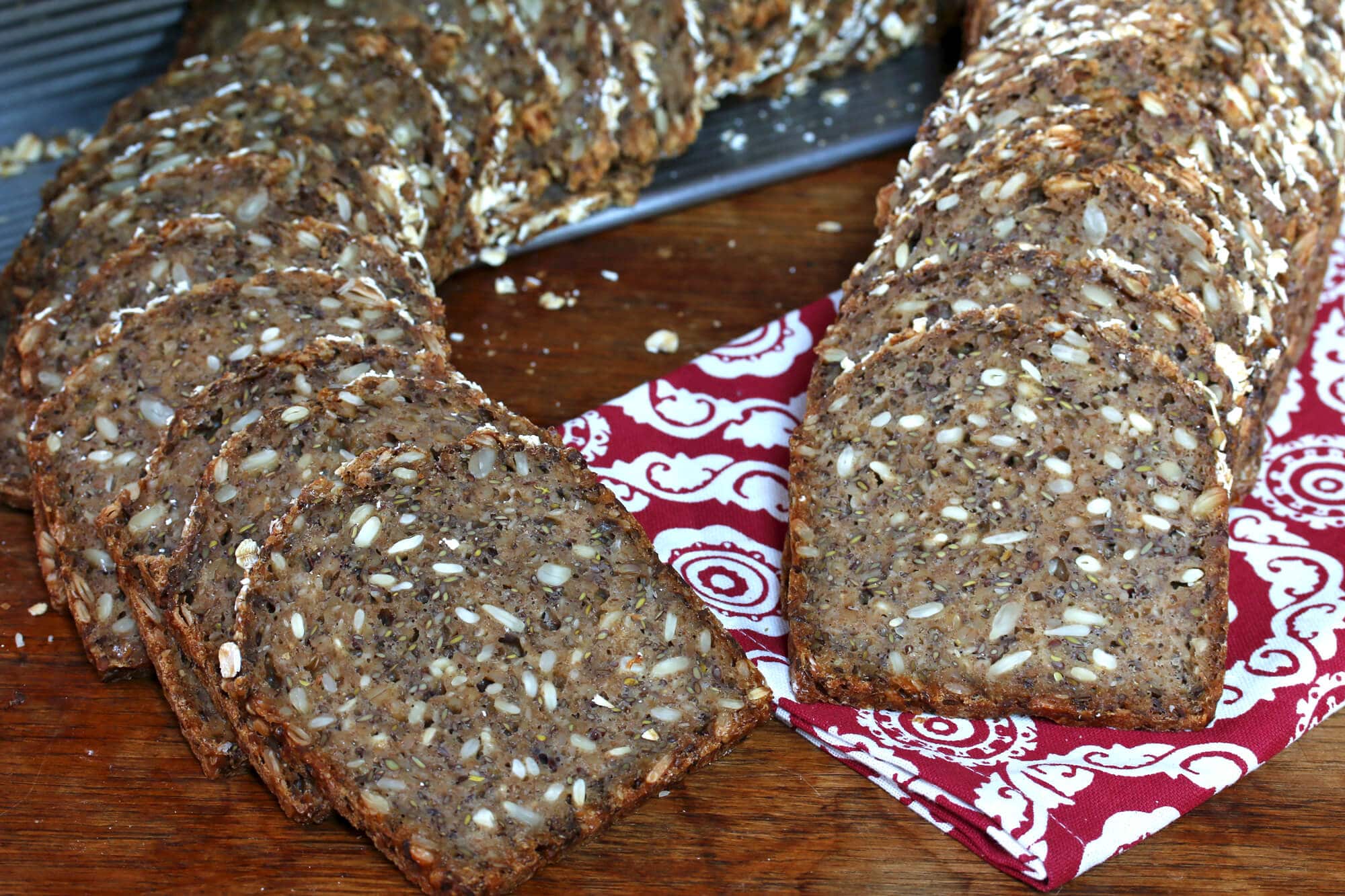
Have you heard of the grain einkorn before? Modern day wheat over the centuries has undergone a series of genetic changes for the purpose of increasing yield and gluten content. It’s almost unidentifiable compared to its ancestor (and my guess is that is why gluten issues are a more recent occurrence). Einkorn is the most ancient form of wheat on earth and hasn’t undergone these genetic changes. It is the purest form of wheat we have. You can purchase einkorn online HERE.
The advantages of einkorn: Most agree it tastes better than wheat and is much easier to digest, even easier than spelt. Compared to the gluten in modern day wheat, it contains a structurally different composition of gluten that the body is able to digest more easily. In fact, some people with gluten issues who have switched to einkorn have found that they’re able to tolerate and digest it with ease.
Even visually there’s a difference between wheat and einkorn. Though there are size variations within different types of wheat, generally most wheat (left) is longer in length than einkorn (right). Einkorn also has a deeper caramel color.
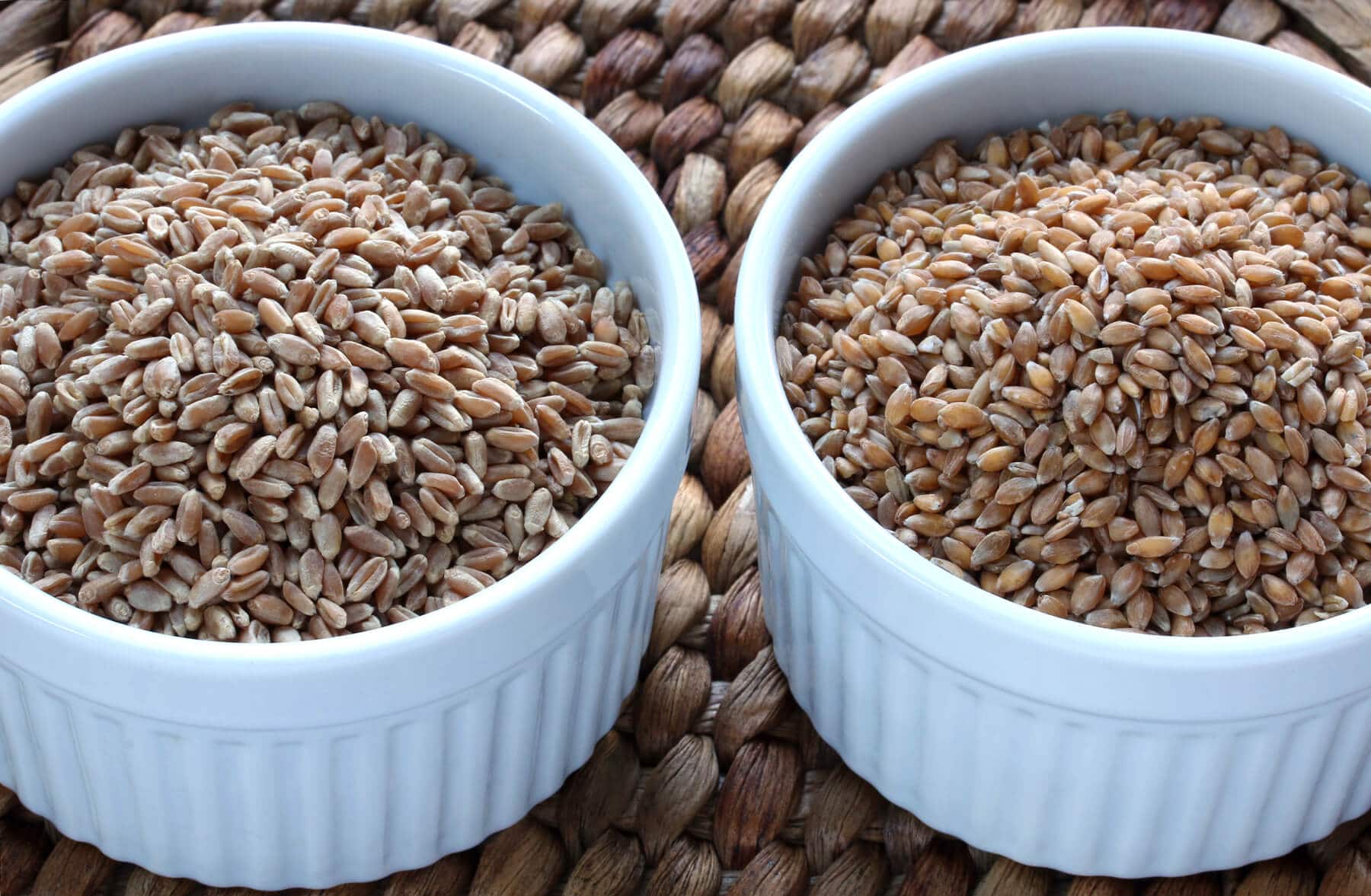
It’s unfortunate that as wonderful as Einkorn is, and common as Einkorn is in many places throughout western Europe, it’s almost unheard of here and very few places sell it. And for that reason it’s also much more expensive here in the U.S.. Hopefully that will change as it becomes more common. The same was true of spelt for a long time and though it’s still far less common than wheat here in the U.S. its price-point has gone down.
I buy all of my grains, including einkorn, in bulk. I take out what I need for a few weeks at a time and store the rest in a dark, cool place. It saves money that way and I have easy access to everything I need. And I LOVE being able to grind my own grains fresh as needed and make up my own fresh baking mixes!
My German-made KoMo grain mill is the pride and joy of my kitchen. German engineering at it’s best, the KoMo grain mill is simply awesome. You can grind your grains as fine or as coarsely as you like. With a 12-year warranty this thing is a work-horse and does a magnificent job. I use it nearly every day grinding my own flours, making cornmeal and a variety of mixes. I cannot recommend it highly enough.
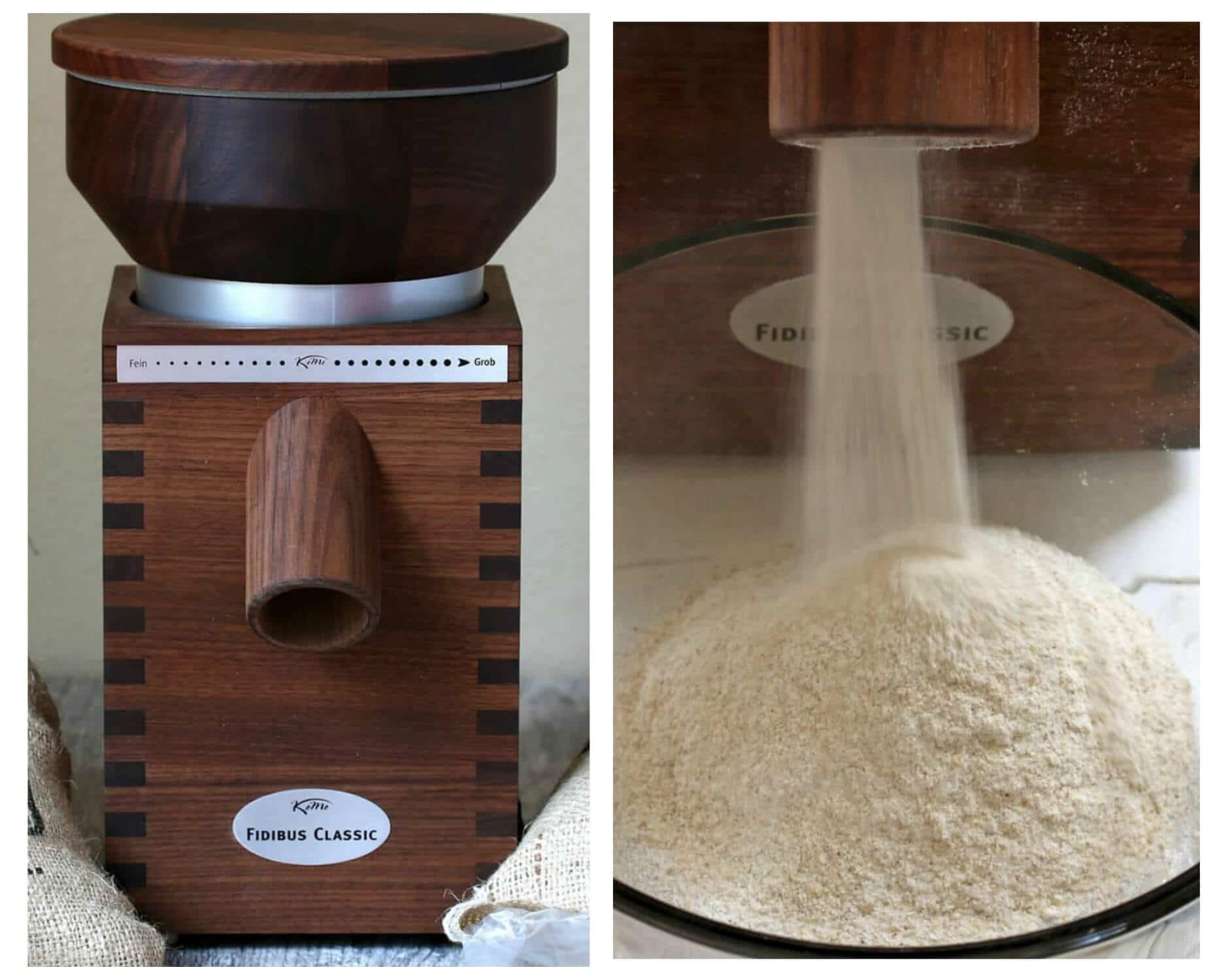
This traditional German bread uses a combination of whole einkorn berries and ground einkorn flour. Whether you’re grinding your own grains or buying the flour already ground, you’re absolutely going to love the texture and flavor of this wonderfully hearty, rustic and thoroughly authentic German bread!
German Sourdough Bread
A couple of our readers have reported back about using sourdough starter instead of yeast. To make this a sourdough Vollkornbrot omit the yeast, add 200 grams of active sourdough starter, and reduce the flour by 100 grams and the water by 100 grams. Give the batter a full 24 hour ferment.
German Bread Recipe (Vollkornbrot)
Let’s get started!
Dissolve the yeast and sugar in the lukewarm water and let sit for 5-10 minutes until frothy. (See above if you prefer to use sourdough starter.)
Place all of the dry ingredients in the bowl of a stand mixer. (You can do this by hand if you prefer.)
NOTE: I personally don’t pre-soak the whole or cracked grain berries and let my batter ferment for a full 24 hours which softens the berries. Depending on the age of the grains you’re using they may require a pre-soaking in order to be adequately soft. If you wish you can pre-soak the grains overnight (pour hot water over them and let them sit) and then thoroughly drain for an hour or so.

Add the yeast mixture along with the buttermilk and beer. Knead on the bread setting (#2) for 10 minutes.
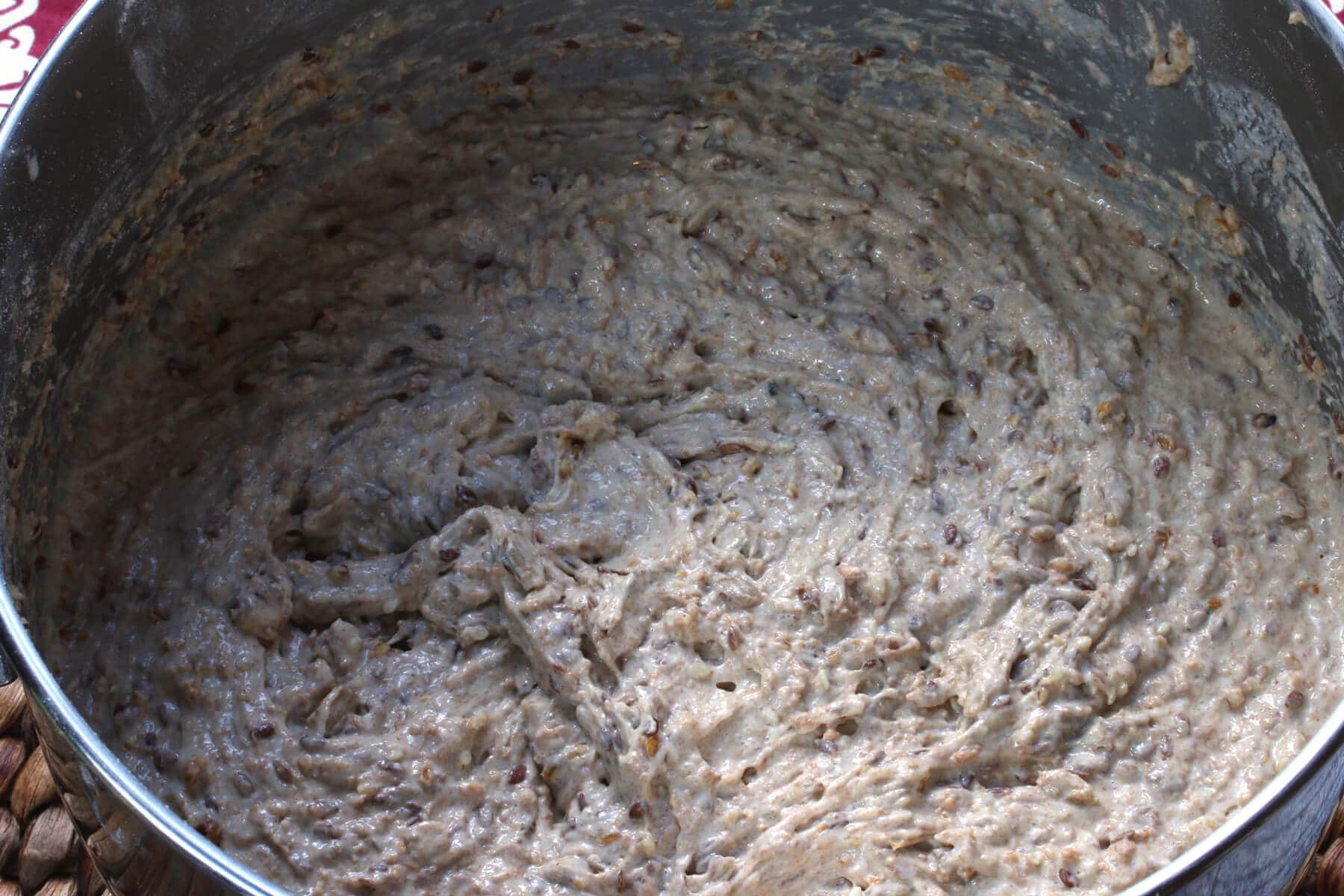
Scoop the mixture into a non-reactive bowl, cover loosely with plastic wrap and let it sit at room temperature for at least 8 hours, preferably longer, up to 24 hours (the longer the better for the whole grain berries to soften and for heightened sourdough properties. If you’re letting it sit for less than 24 hours, presoak the grains overnight in advance and drain thoroughly). Also, the longer it ferments the more liquid will be absorbed so less chances of a moist center after baking.
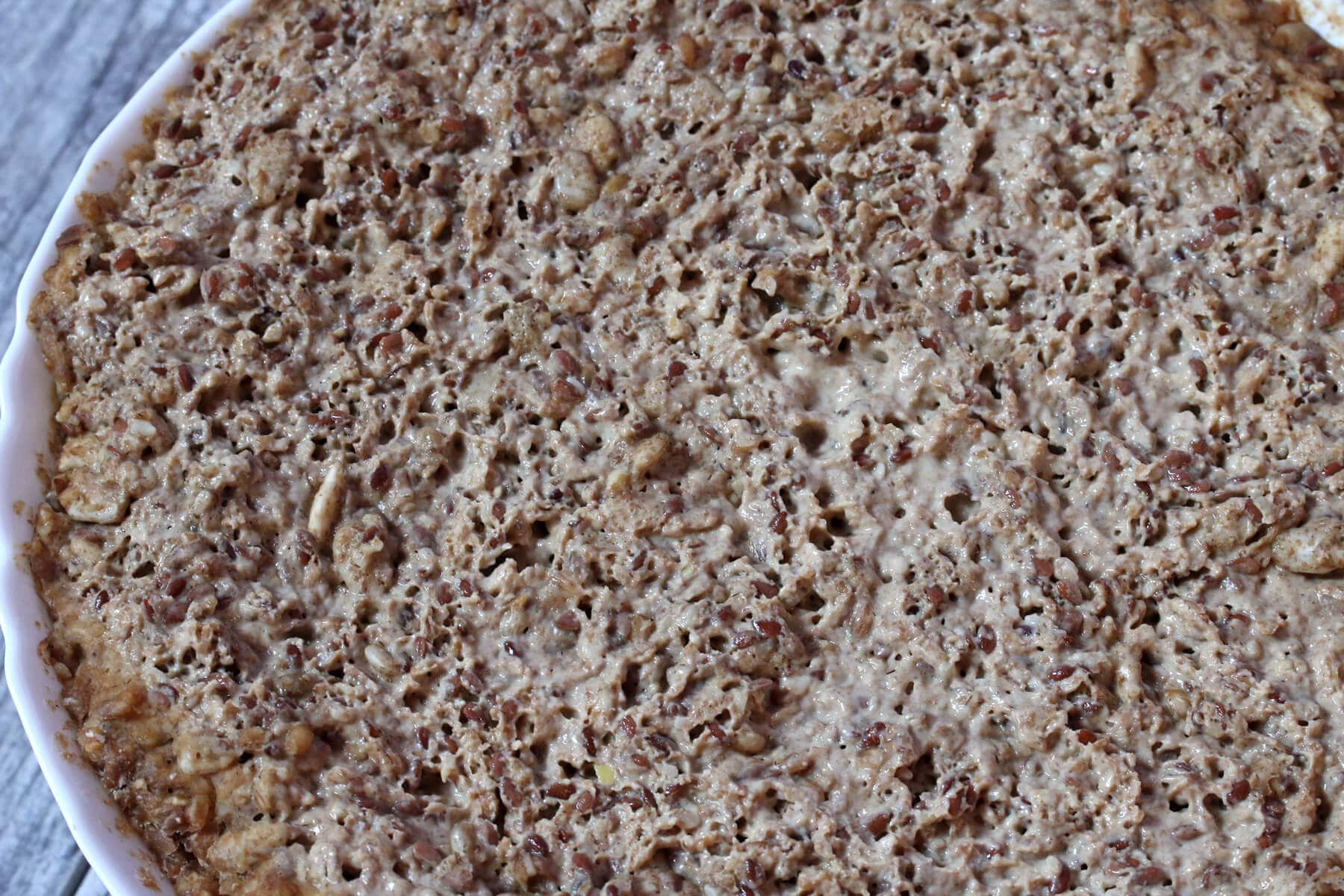
The mixture will be thick and gooey but will not resemble typical bread dough.
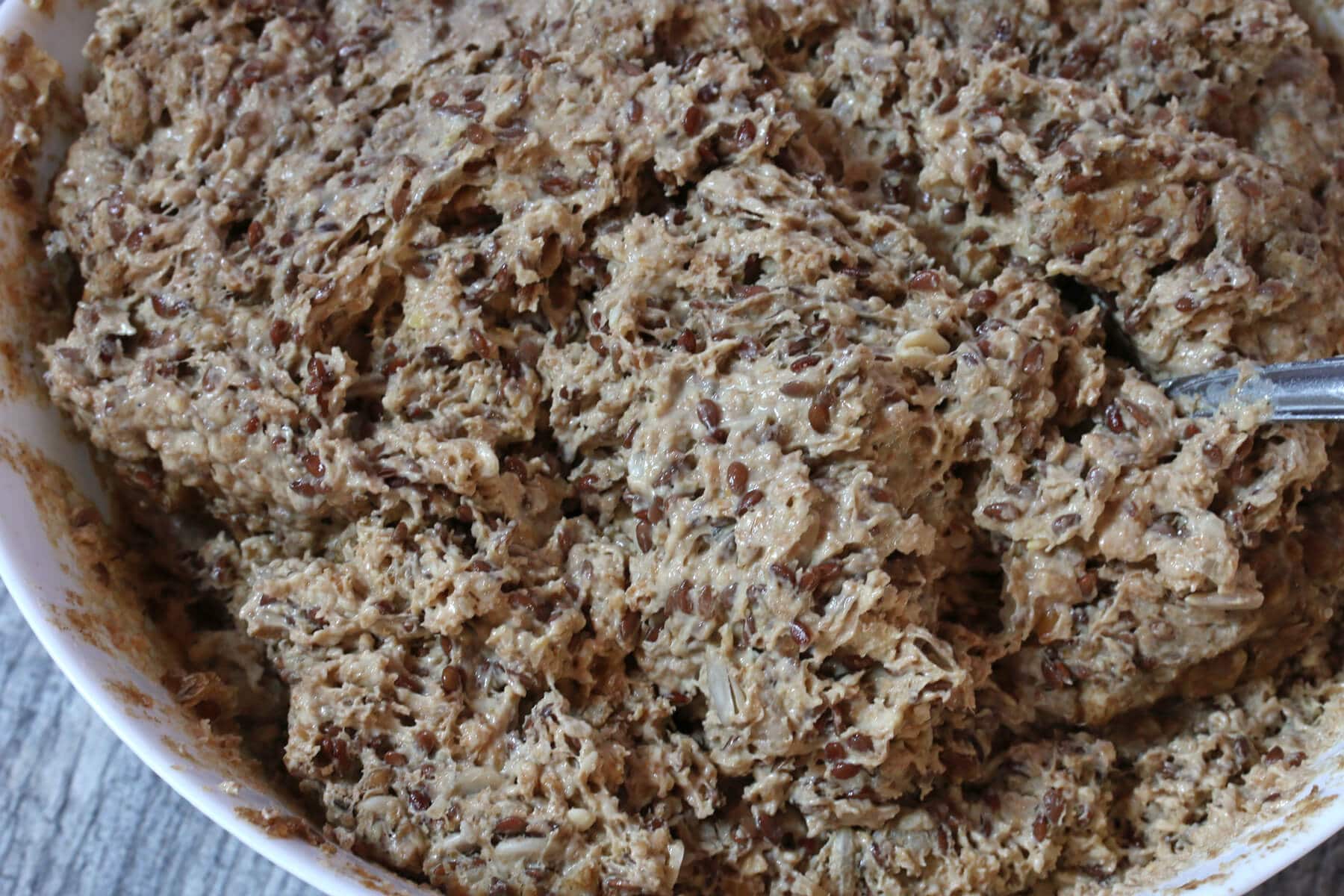
Scoop the mixture into a generously buttered Pullman Loaf Pan and smooth the top so it’s even.
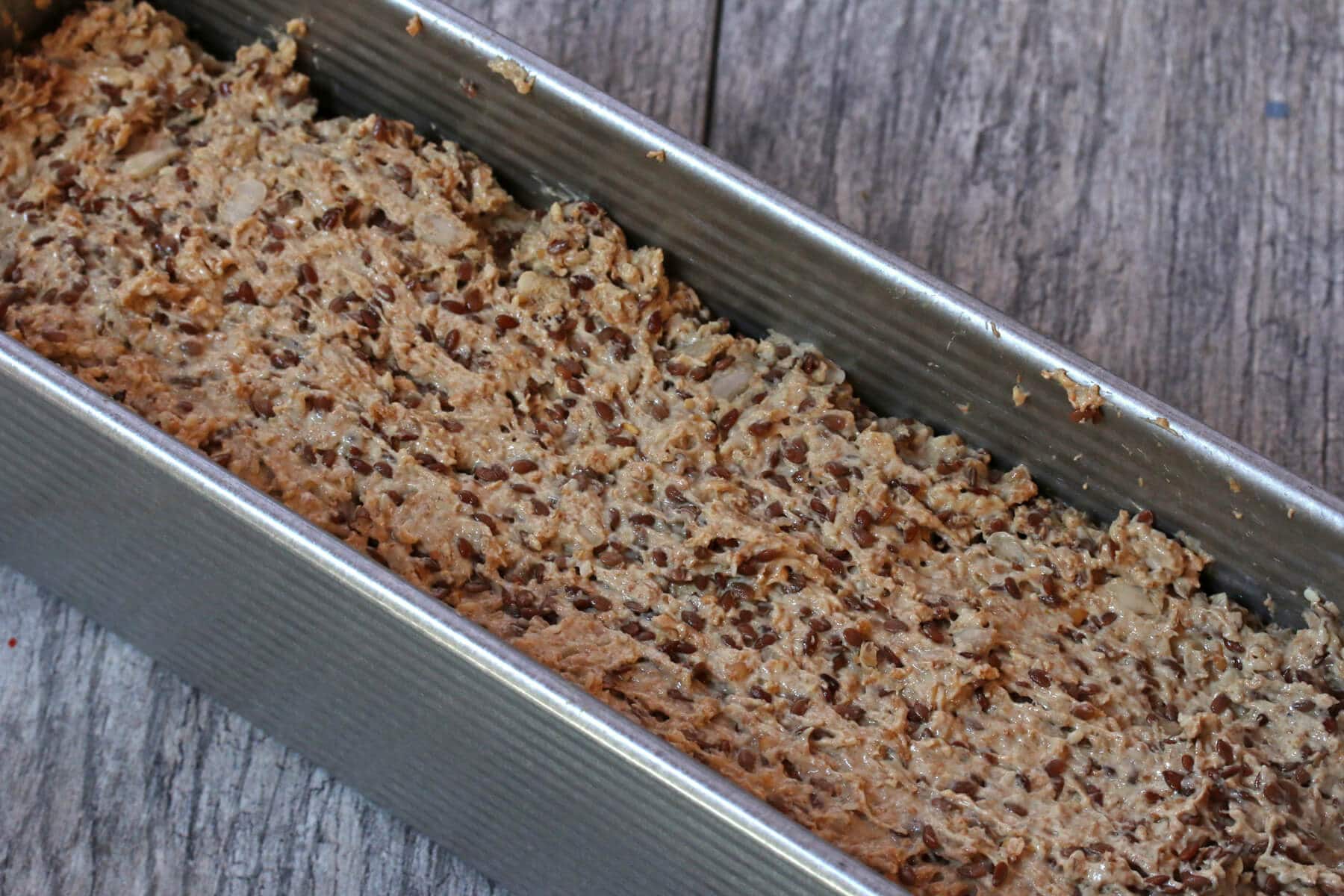
Baking this bread in a Pullman loaf pan yields those nice small, square slices of bread. But it also helps ensure that the center of the bread is fully cooked. Plus, when I’m making other breads that rise a lot, the Pullman has a top on it that slides shut to keep the bread compact (this Einkornbrot doesn’t rise a lot during baking so I don’t bother putting the lid on for it). It’s also the loaf pan that is used to make the famous French pain de mie bread. I like to use it for a lot of my heartier European style breads.
Sprinkle the top with rolled oats.
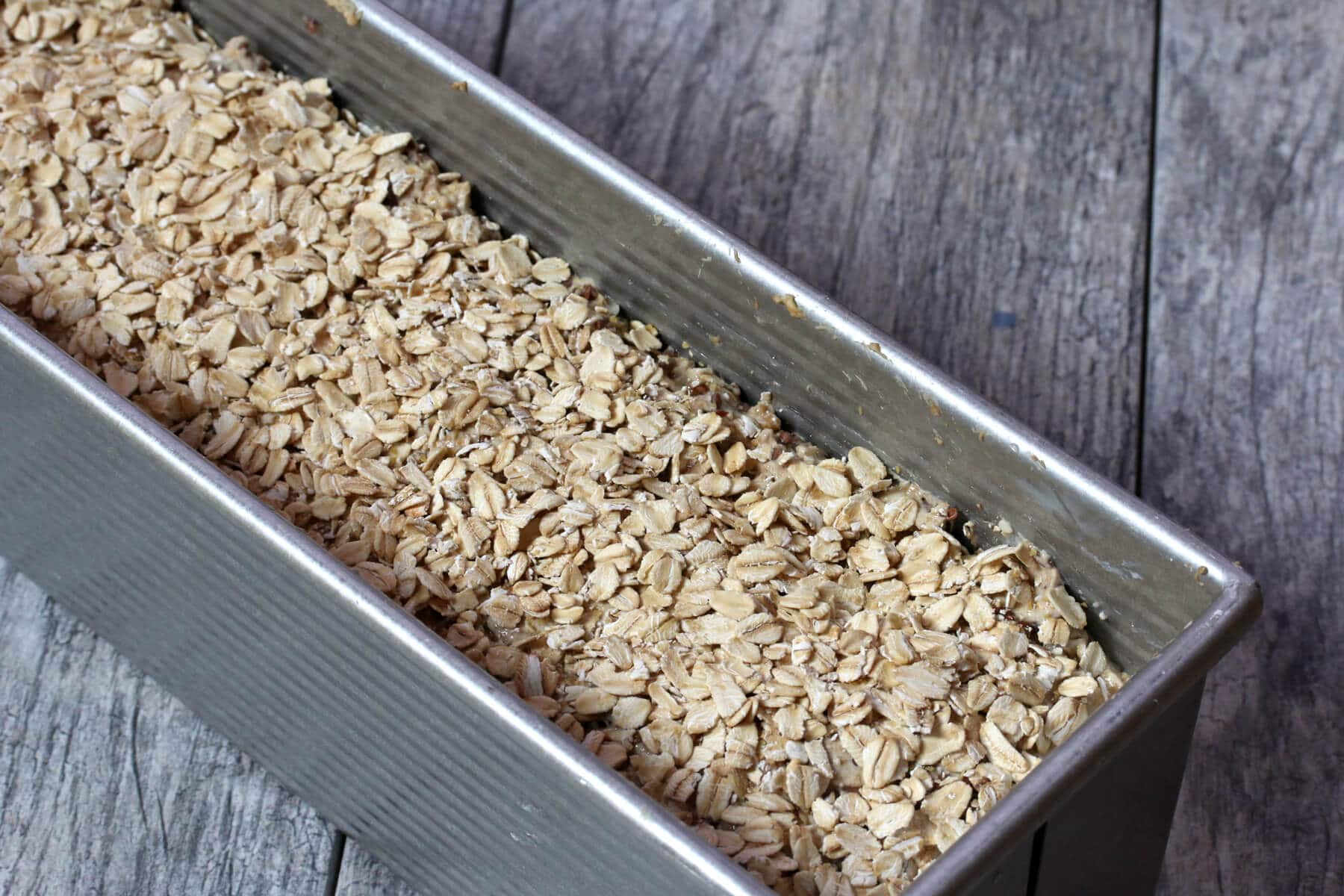
In an oven preheated to 350 degrees F, bake it on the middle rack for 100-120 minutes or until the center is done.
For best and most accurate results, use an instant read thermometer and aim for an internal temperature of 205-210 degrees F.
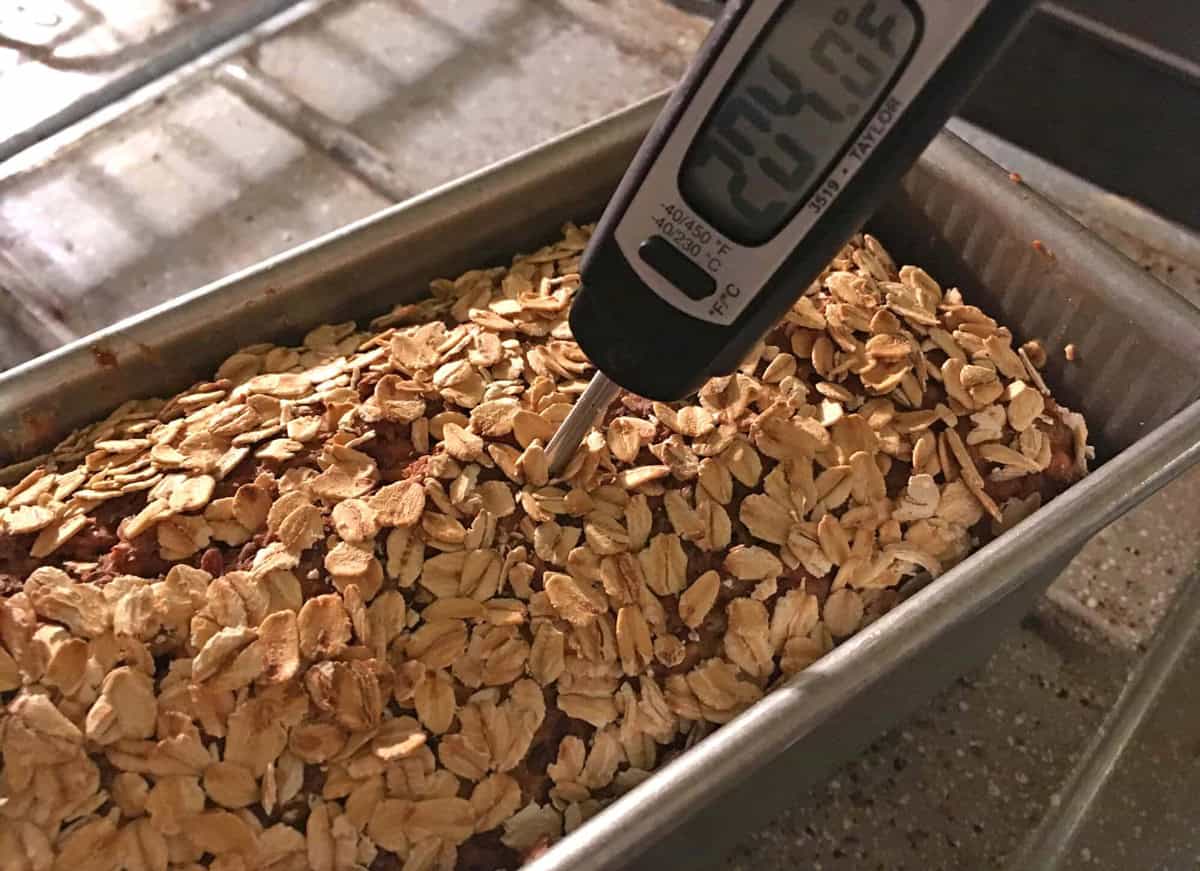
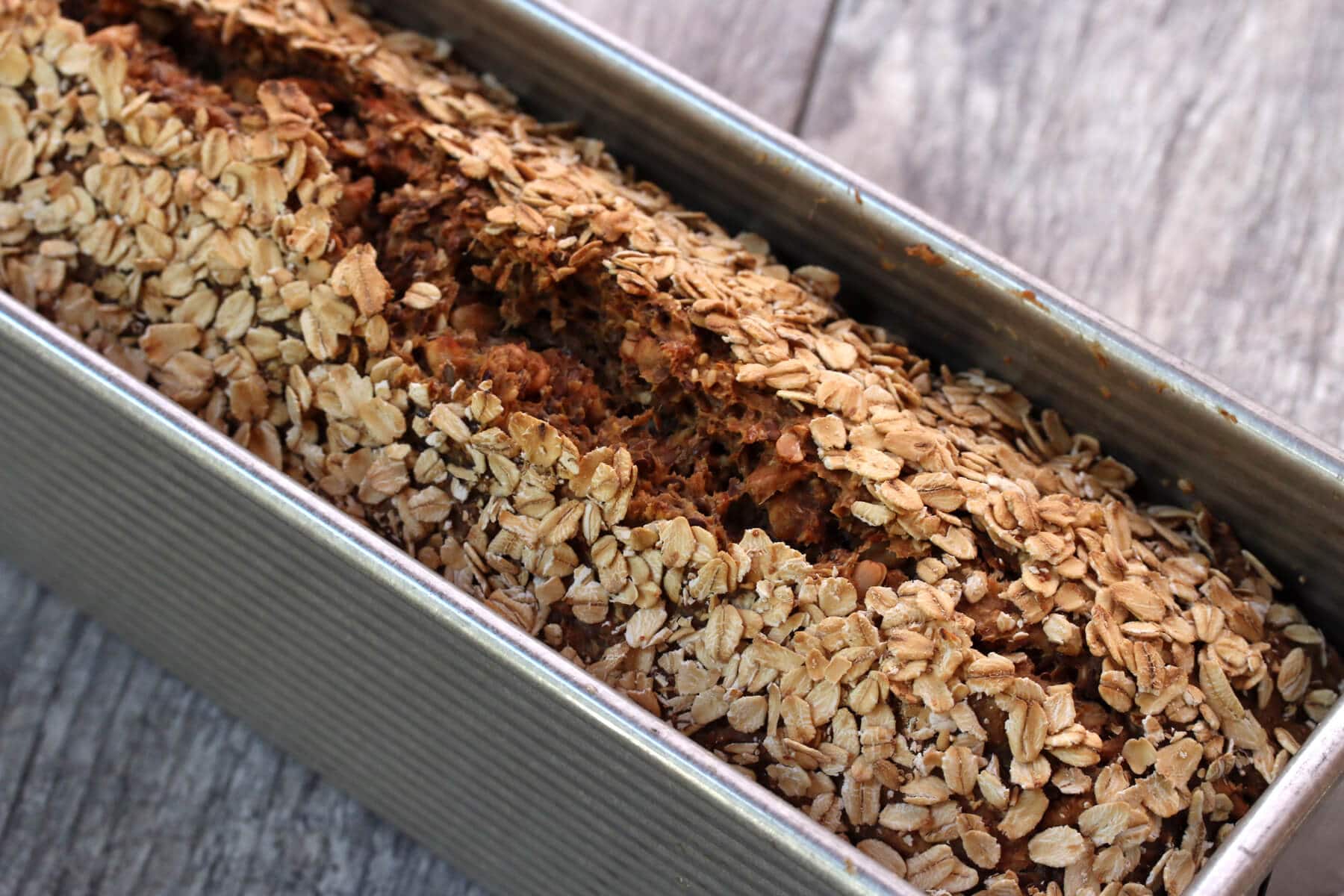
Let is sit in the pan for 5 minutes before removing it, then let it cool completely on a wire rack.

Once cooled you can slice the entire loaf in advance or slice as needed.

We have a decades-old Hobart commercial slicer that we picked up on Craigslist years ago. I used to be the manager of a delicatessen in England and Hobart is the gold standard in food slicers. In fact, the very same model that we have is on display at the Smithsonian!
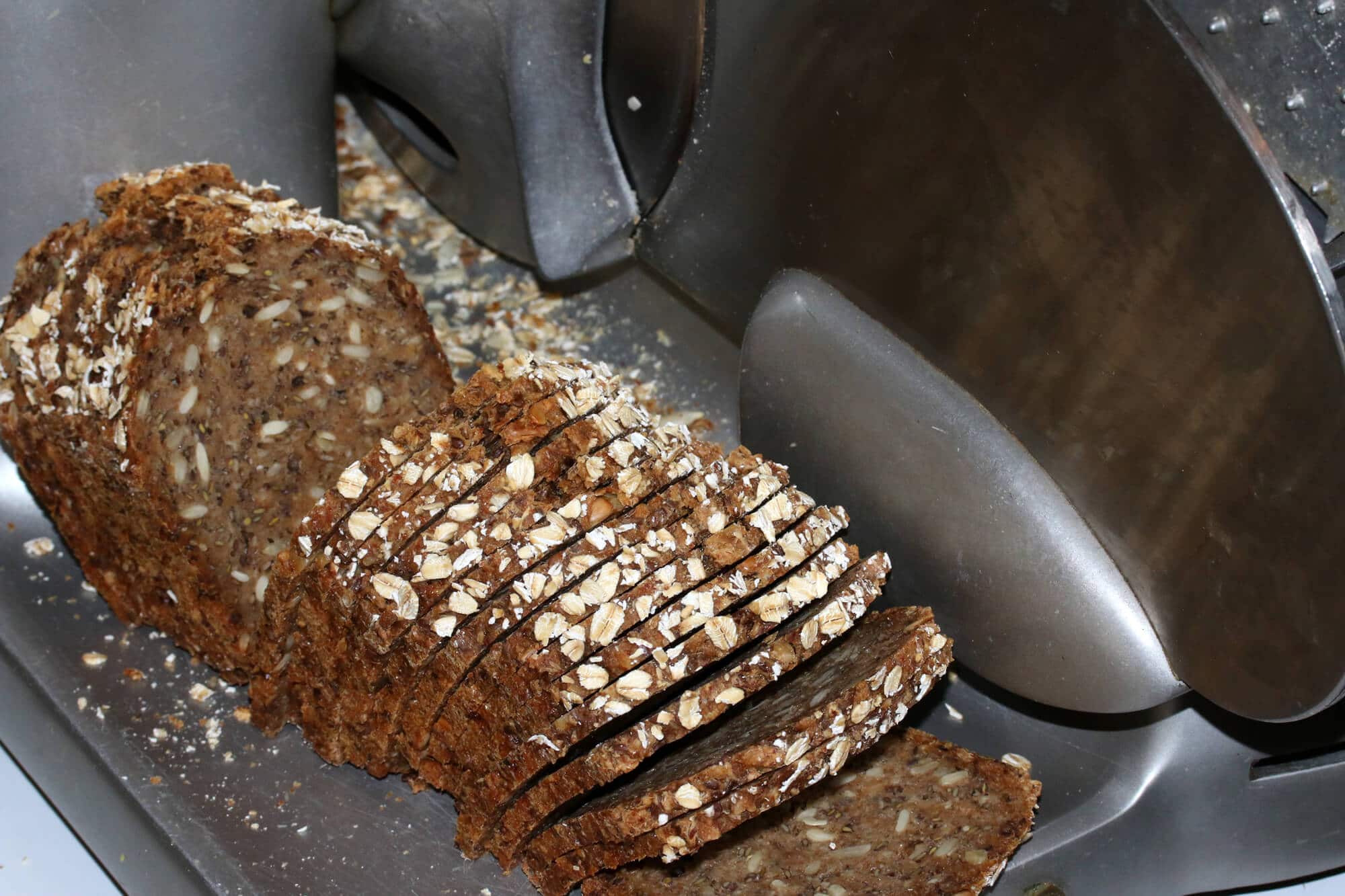
I realize we got lucky and most of you aren’t going to find a good-priced Hobart on Craigslist, but there are other good slicers on the market that are vastly cheaper and do the job. Chef’s Choice Slicers are consistently ranked at the top. I haven’t personally tried one, but they get excellent reviews. Having a good slicer to get clean, thin slices of bread that look like something you bought at a professional bakery is really nice. Plus, whenever I find chunks of cooked ham, turkey or cheese on sale I get those and slice them myself – it’s much cheaper than buying them at the deli.
At the very least you’ll need an excellent bread knife and for that my favorite knife, hands down, is the Cutco 9 3/4″ Slicer. It glides smoothly through bread and meat like no other.
Enjoy!

For more delicious bread from around the world be sure to try my:
- Lavash
- Injera
- Dosa
- Sourdough Naan
- Danish Rye Bread
- Crumpets
- Olive Rosemary Focaccia
- Skillet Cornbread
Save This Recipe
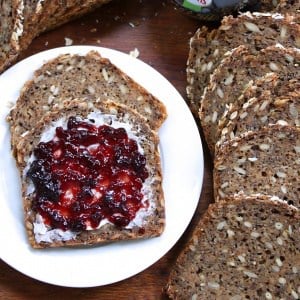
German Bread (Authentic Vollkornbrot)
Ingredients
- 4 1/2 cups einkorn flour (you can also use whole wheat, spelt, rye or combination)
- 1/2 cup whole einkorn berries , or wheat, spelt or rye berries (***See NOTE about soaking)
- 1 3/4 cups cracked einkorn berries , or wheat, spelt, rye (**See NOTE about cracking the grains **See NOTE about soaking)
- 1 cup whole flax seeds
- 1 1/2 cups sunflower seeds
- 1/4 cup sesame seeds
- 3 teaspoons salt
- 2 teaspoons dry active yeast ** see Note for sourdough substitution
- 2 tablespoons sugar , optional but recommended
- 2 cups lukewarm water
- 2 cups buttermilk , at room temperature
- 1 cup mild beer (optional, for a maltier flavor) , at room temperature (can substitute water or buttermilk instead)
- Rolled oats for sprinkling
Instructions
- Dissolve the yeast and sugar in the lukewarm water and let it sit for 5-10 minutes until frothy.
- Combine all of the dry ingredients in the bowl of a stand mixer. (You can do this by hand if you prefer.) Then add the yeast mixture along with the buttermilk and beer. Attach the dough hook and knead on the bread setting (#2) for 10 minutes. Scoop the batter into a large non-reactive bowl, cover loosely with plastic wrap, and let it sit at room temperature for at least 8 hours, preferably longer, up to 24 hours (the longer the better for the whole grain berries to soften and for heightened sourdough properties. Also the longer it ferments the more liquid will be absorbed so less chances of a moist center after baking.)
- Preheat the oven to 350 degrees F.
- Scoop the batter (it will be thick and gooey but not like regular bread dough) into a generously buttered 13x4x4 Pullman loaf pan and smooth the top to even it out. Sprinkle with oats. (Note: Baking this bread in a Pullman loaf pan yields those nice small, square slices of bread. But it also helps ensure that the center of the bread is fully cooked.) I always bake this without the lid on.
- Bake on the middle rack for 100-120 minutes or until the center is done. For best and most accurate results use an instant read thermometer and aim for 210 degrees F. Let the bread sit in the pan for 5 minutes before removing it, then let it cool completely on a wire rack before slicing it. To get clean, professional slices I highly recommend using a bread slicer.
Notes
- How to “crack” the whole berries: I use my grain mill to crack them by putting it on the coarsest setting. Another option is if you have a Vitamix and use the dry container – pulse the whole berries a few times until you get coarse pieces of einkorn. A powerful food processor will likewise do the job. Alternatively you can also place the whole berries in a ziplock bag and use a heavy object to pound them to break them up.
- Soaking the Grains: I personally don’t pre-soak the whole or cracked grain berries and just let my batter ferment for a full 24 hours which softens the berries, and I’ve always had great results. However, depending on the age of the grains you’re using (even if you just bought them they may have sat in the store or warehouse for a long time) they may require a pre-soaking in order to be adequately soft. If you wish you can pre-soak the grains overnight (pour hot water over them and let them sit) and then thoroughly draining.
- **Sourdough Substitution: To make this a sourdough Vollkornbrot omit the yeast, add 200 grams of active sourdough starter, and reduce the flour by 100 grams and the water by 100 grams. Give the batter a full 24 hour ferment.
Nutrition
Originally published on The Daring Gourmet December 11, 2019



















Thank you for sharing your wonderful recipe! I’m new to einkorn flour and fermented bread but a pretty experienced sourdough/bread baker. I did measure the flour by scoops after reading a comment that alerted me to that possibly being an issue. Just out of curiosity I compared the weight of what the package said 4.5 cups would weigh with what my actual scoops of flour weighted and it was very different (i.e. 432g vs 584g). I went with the 584g and it worked beautifully. I fermented it a full 24 hrs. I did use barley syrup instead of sugar and a Belgium blond beer and was pleased with the flavor – although it isn’t quite as dark as your bread. I used the pullman pan you recommended and baked it on top of a baking stone for 125 minutes total (it was at 203.5 F at 120 minutes so I popped it back for another 5 minutes and it rose to 206.6F). My husband and I have just enjoyed a slice and I can’t wait to try more of your recipes!!!!
Thank you so much for that feedback, Claudia, I’m so glad you and your husband enjoyed this!
I lived in Germany for two years and fell in love with this bread for Abendbrot. My question is this, since I DO NOT use baker’s or instant yeast, how can I make this using a sourdough start?
My husband had volkornbrot from a local bakery and fell in love with it! He read more about it and learned it was traditionally made with einkorn, which our local bakery didn’t use. He had me intrigued and I found your recipe and we ended up investing in the baking pan and multiple bags of einkorn flour and einkorn berries… thankfully it was money well spent and my husband says our homemade loaves are better than the one we purchased. I’ve added pumpkin seeds, flax seeds, ground flax – depending on what we had on hand – and started adding oats to my dough to absorb some of the moisture when it seemed “too wet”. (I started weighing my einkorn flour and have found my dough seems wetter than when I used measuring cups.) in any event – this recipe does well with substitutions and we’ve loved all our variations. Thanks for your wonderful recipe!
I’m absolutely thrilled to hear that, Suzanne, thank you so much for the feedback! For the weighed amount, did you use the metric conversion in my recipe card (to the right of the ingredients there’s a “US Customary” and a “Metric” button)? The conversion software indicates 575 grams of flour. Is that what you used?
Like many other commenters, I’ve had an interest in making this bread with my sourdough starter after baking it a few times with yeast with great results. I have made the bread twice with sourdough so far. Like someone else posted already, I replaced the 2 tsp of yeast with 227g of my sourdough starter/levain at 100% hydration. I reduced the water from 500ml to 382ml to make up for the liquid in my levain.
The first time I let the mixed dough sit at room temperature for 24 hours. While the dough looked OK and it baked like I was used to, the finished bread had a very sour, almost smoky smell and taste to it. Still edible for sure, but not as good as I hoped. It looks like the 24 hours at room temperature led to an overproofed dough. The yeasted dough probably isn’t as susceptible to overproofing compared to the sourdough.
The second time I decided to refrigerate the dough for part of the 24 hours. My levain was a little slow on the day of mixing the dough so I actually mixed all the other ingredients aside from the levain and let them sit for about 6 hours at room temperature. I then added the levain and let the dough sit for another 8 hours at room temperature. I then refrigerated the dough for another 10 hours before baking it in a 13x4x4 Pullman pan for about 2 hours and 20 min. It came out great this time. It actually rose quite a bit above the top of the pan, which didn’t happen in previous attempts with sourdough or yeast. The texture was perfect and it tastes great.
A couple of other substitutions I made to the recipe is to replace sugar with barley malt syrup and to replace the buttermilk with oat milk and lemon juice.
Thank you for sharing this recipe, Kimberly! I literally grew up on Vollkornbrot in Germany and had it every morning for breakfast and in school for as long as I can remember. It’s great to be able to bake my own now.
That’s fantastic, Juergen, thank you so much for the detailed feedback on your sourdough process!
Hi Kimberly,
I want to thank you for this. I first had volkornbrot when attending university and couldn’t figure out how to make it. I have now been making it for two years thanks to you. I ship einkorn from the opposite end of the country and grind it myself with my KoMo mill. I have tried several variants adding pumpkin seeds, caraway, walnuts and raisins and using double the beer, mead, apple cider and coffee. Also I have added 3 TBSP of good high fat cocoa and molasses too. It is so flexible and always produces a great result.
That’s terrific, Cal, I really appreciate the feedback and am thrilled that this has become a go-to for you – thank you! Agreed, it’s a very “flexible” recipe in terms of swapping out different ingredients and adding a few additional ones.
Hi Kimberly!
I would love to try your recipe but since I love 100% or close to 100% rye bread I would like to hear your opinion what would be the proportion of rye flour and spelt (this is what I am planning to use) to get as much rye as possible (I have dark/medium/light rye flours). I was thinking 0.5 cup of bread flour, 1 cup of spelt+1 cup of light rye+2 cups of dark rye. Can I use more rye? I also would love to use oat bran. Do I use it instead of flour or instead of cracked berries
Thank you
Hi Inna, you can use 100% rye if you prefer or any combination and ratio of wheat varieties. And yes, you can replace some of the flour with oat bran. I would aim for about 1 cup of oat bran as you generally only want to substitute 1/4 of the flour with bran when making bread. Happy baking!
This is the best bread recipe we have ever found! Plain, with jam/jelly, toast, sandwich, etc. any way you can think of, just the perfect bread. My husband and I travel to Germany every year to train dogs and fell in love with German food. I hate to admit it…but this is better than the bread we had there and even shared the recipe with our German K9 family and they LOVE it! Well done! Thank you for introducing me to Einkorn flour as well, I use it in almost everything now.
Now we just need to see some good Serbian recipes here :-)
I am positively thrilled to hear that, Milica, thank you so much for the compliment! :) And I can’t argue with you about the Serbian recipes; a restaurant I frequently enjoyed going to in Germany was a Serbian one – great food :)
Completely awesome, healthy bread!,, I have substituted different and various seeds (pumpkin, chia) nuts ( pistachio, sliced pine nuts) or currants at different times. Really hard to mess it up too much
Fantastic, Bob, thanks so much!
Thank you so much for sharing this recipe. I was hoping you had some advice. I followed your instructions pretty carefully but my bread came out quite bitter. Do you have any recommendations on how to make it less bitter?
Hi Sabrina, if you used beer it may be the particular beer that you used – some are quite bitter. The other component could be the fermentation time – the longer the batter ferments the more sour the bread will be, so you can reduce the fermentation time.